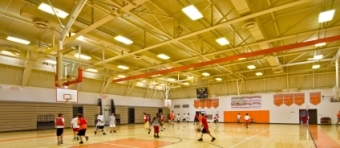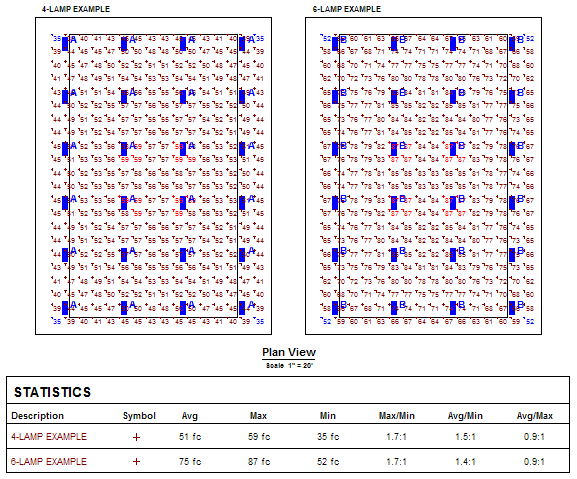
For years, the standard method of
lighting gymnasiums has been the 400W Metal Halide High Bay. This has led to gyms with deteriorating light levels and poor playing conditions that are expensive to operate. New technologies have allowed lighting designers to specify
T5 High Output (T5HO) Fluorescent High Bay Fixtures in place of the more inefficient metal halide fixtures. This shift has reduced the power consumption of gymnasium lighting systems, provided better quality light for all sports activities, and has allowed for a more versatile environment in school or recreational center gyms.
This post provides guidance on how to
retrofit a gymnasium with more energy efficient lighting. We will use a typical high school gym as a base for our energy savings and provide example lighting layouts with point-by-point light levels.
Energy Efficiency
Traditional 400 W Metal Halide high bays consume a total of 454 Watts of power - 400 Watts for the lamp and an additional 54 watts of ballast power. By comparison, a
4-lamp T5HO fixture consumes only 228 Watts of power while a
6-lamp T5HO fixture consumes 342 Watts. This lower energy consumption allows for a reduction in total lighting system consumption and therefore a lower electric bill.
To provide concrete numbers, let's work with an example high school gym and assume we're investigating replacing 24 existing 400W Metal Halide fixtures with T5HO fluorescent fixtures. The table below summarizes the costs associated with lighting this gym assuming a cost of $0.10 per kWh and an annual usage of 2,500 hours.
| Fixture Type |
400W MH |
4-Lamp T5 |
6-Lamp T5 |
| Fixture Wattage |
454 W |
228 W |
342 W |
| Fixture Quantity |
24 |
| System Power
Consumption/Hour |
10,896 kW |
5,472 kW |
8,208 kW |
| Lighting Cost/Year |
$2,724 |
$1,368 |
$2,052 |
| Savings/Year |
- |
$1,356 |
$672 |
T5HO High Bays in Gymnasium Applications
Light level recommendations for gymnasiums range from 30 foot candles (fc) for recreational gyms to over 100 fc for professional gymnasiums used to televise sporting events.
Adding additional details to our example gym above, we can provide expected light levels for our retrofit project. Let's say that our example gymnasium is 100' long by 60' wide (typical dimensions for high school or junior high school gyms). The ceiling is 20' high and the fixtures are mounted 18' from the floor. Using typical reflectance levels for all of the surfaces, we can calculate the expected light levels in this gym as follows.
| Fixture Type |
400W MH |
4-Lamp T5 |
6-Lamp T5 |
| Expected Light Level |
varies |
51 fc |
75 fc |
We've listed the light level in the 400 W Metal Halide column as varied because depending on their age, the metal halide fixtures can have a vastly varying level of light output. As metal halide lamps begin to "burn out", the halides in the arc tube that give the lamp it's initial bluish white color fail at different rates. When this occurs, it causes the metal halide lamp to shift color to green, pink or yellow as its end of life approaches. This color shift also leads to lumen depreciation that will cause the lamp to deliver less than half of its initial light output while still consuming the same 454 watts of electricity.
CRI or Color Rendering Index is greatly improved with
T5 fluorescent lamps. The high quality tri-phosphor coatings used in our T5 lamps deliver a CRI index of 90 - more than 20 points higher than standard metal halide lamps. In a
gymnasium application this is very important for visual acuity and to allow greater differentiation between objects of similar colors.
The diagram below provides point-by-point light levels for both the 4-lamp and 6-lamp layouts.
 RelightDepot
RelightDepot can provide customized lighting layouts for your gymnasium with the same level of detail shown in these diagrams. Don't hesitate to
contact us if you would like to see what results you can achieve in your gym.
February 21, 2010 by Ray De Varona.
 For years, the standard method of lighting gymnasiums has been the 400W Metal Halide High Bay. This has led to gyms with deteriorating light levels and poor playing conditions that are expensive to operate. New technologies have allowed lighting designers to specify T5 High Output (T5HO) Fluorescent High Bay Fixtures in place of the more inefficient metal halide fixtures. This shift has reduced the power consumption of gymnasium lighting systems, provided better quality light for all sports activities, and has allowed for a more versatile environment in school or recreational center gyms.
This post provides guidance on how to retrofit a gymnasium with more energy efficient lighting. We will use a typical high school gym as a base for our energy savings and provide example lighting layouts with point-by-point light levels.
For years, the standard method of lighting gymnasiums has been the 400W Metal Halide High Bay. This has led to gyms with deteriorating light levels and poor playing conditions that are expensive to operate. New technologies have allowed lighting designers to specify T5 High Output (T5HO) Fluorescent High Bay Fixtures in place of the more inefficient metal halide fixtures. This shift has reduced the power consumption of gymnasium lighting systems, provided better quality light for all sports activities, and has allowed for a more versatile environment in school or recreational center gyms.
This post provides guidance on how to retrofit a gymnasium with more energy efficient lighting. We will use a typical high school gym as a base for our energy savings and provide example lighting layouts with point-by-point light levels.
 RelightDepot can provide customized lighting layouts for your gymnasium with the same level of detail shown in these diagrams. Don't hesitate to contact us if you would like to see what results you can achieve in your gym.
RelightDepot can provide customized lighting layouts for your gymnasium with the same level of detail shown in these diagrams. Don't hesitate to contact us if you would like to see what results you can achieve in your gym.
